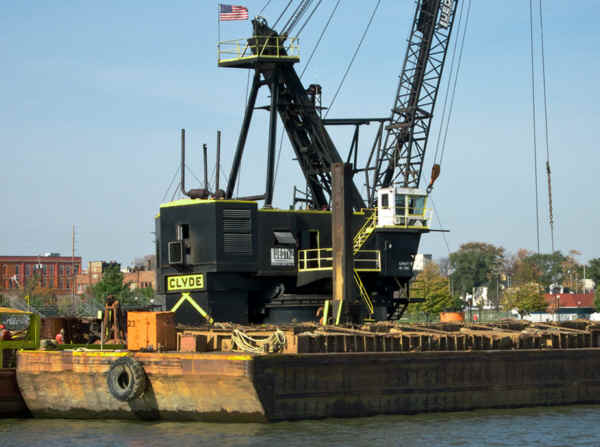 Dredges of Luedtke Engineering arrived on the river near the DoubleTree Hotel this week to begin a maintenance project for the U.S. Army Corps of Engineers. (MyBayCity Photos by Andy Rogers)
Dredges of Luedtke Engineering arrived on the river near the DoubleTree Hotel this week to begin a maintenance project for the U.S. Army Corps of Engineers. (MyBayCity Photos by Andy Rogers)
Hooters Bar is Not For Drinks, But A Saginaw River Shoal Needing Dredging
Low Water Problem Plaguing Great Lakes is a Major Problem for Shippers Here
October 31, 2007
By: Dave Rogers
Dredges of Luedtke Engineering arrive on the river.
(MyBayCity Photo by Andy Rogers)
A 177-year-old low water problem is returning to haunt the antecedents of ship captains of old.
Dredging of high spots in the Saginaw River is underway but a handy new disposal site sits unused on the border of Zilwaukee and Frankenlust Township, Bay County.
The river is as low as 13 feet in spots while it should be a uniform 22 feet deep, according to the U.S. Army Corps of Engineers.
Shipping interests headed by the Saginaw River Alliance, a group of 30 firms now headed by William Webber of Sargent Sand, Saginaw, have been working for about 20 years to obtain the disposal site to ease problems with dredging.
The Alliance honored Jim Koski, Saginaw County public works commissioner, last week at a dinner in the Horizons Conference Center, for his longtime efforts to obtain the disposal site and support of river shipping interests.
Shippers are losing hundreds of thousands of dollars because of the low water: to traverse the river ships must come and go without full loads. Every inch ships can't load costs about $8,400 in lost revenue, according to Great Lakes shipping associations.
Held up at first by environmental concerns and lawsuits, the disposal site now is subject to a bureaucratic snafu. State and federal agencies are wrangling about how it is to be used.
The Michigan Department of Environmental Quality (DEQ) has come under fire for holding up the use of the new disposal site. One critic said "the DEQ has been infiltrated by environmental groups who want to block everything."
On the sidelines is the Dow Chemical Co., Midland-based multi-national firm, that has indicated a need to use the site to confine contaminated materials. It is not yet known if Dow will be allowed to use the site for which the firm has contributed hundreds of thousands of dollars.
Several ships ran aground on the Saginaw River during last year's shipping season, caught in shallow waters both near Saginaw and in Bay City adjacent to Hooters Restaurant.
The last incident led to a new term in the lexicon of river users: the Hooters Bar (marine term for shoal).
Since shipping began in the river in the 1830s, the Carrollton Bar and the Zilwaukee Bar have plagued marine interests. The Carrollton Bar, once just a sand bar, now is a full-fledged island in the middle of the river near the former Saginaw Nodular Iron Foundry.
Water levels that began their decline in 1998 have remained low and dredging has been held up because of lack of a disposal site.
"It's a pretty different mindset to come off 30 years of above-average water levels and to suddenly, since the late 1990s, have below-average levels," said Scott Thieme, chief of the U.S. Army Corps of Engineers' Great Lakes Hydraulics and Hydrology Office in Detroit.
Lakes Huron and Michigan, where water levels have declined the most, are down about 3 feet from 1997 and about 20 inches from their 140-year average, according to the U.S. National Oceanic and Atmospheric Administration's (NOAA) Great Lakes Environmental Research Laboratory in Ann Arbor.
Water levels in the Great Lakes have always fluctuated, but experts point to climate change, dredging, private shoreline alterations and even lingering effects of glaciers to explain the latest changes -- the decline of Lake Huron and slightly higher water levels in Lake Erie, into which Huron flows.
The Dust Bowl drought of the 1930s may have contributed to record low Great Lakes levels. In 1997 a strong El Nino brought warm, dry temperatures and corresponding low water levels
to North America, NOAA officials said.
Above-average temperatures don't create a normal ice cover on the Great Lakes and connected rivers, and more water evaporates away, causing lower levels, experts said.
Some sources say post-glacial rebound -- the slow rise of the earth's crust that has been occurring since ancient times, that may account for declining water levels in Lakes Huron and Michigan.
For every inch water levels go down, ships bound for destinations outside North America forfeit about $8,400 in freight revenue, said Dennis Mahoney, president of the Great Lakes Shipping Association.
Saginaw and other ports have done emergency dredging to accommodate ships and barges up to several hundred yards long. That process is again underway on the river, but dredges have to make the long haul to the island at the mouth of the river started in 1975 and nearly fully filled.
When the new disposal site at Zilwaukee will be able to be used is the great unknown.
"They want to treat it as a sewage lagoon," said Mr. Webber. "The same testing as a sewage lagoon would require two full-time employees."
Alliance members noted the high costs both of readying the new disposal site and of hauling dredged spoil to the mouth of the river, plus the idea of having to test the spoils being deposited in the new site.
"All the politicians care about is emergency or media related," said Mr. Webber.###

